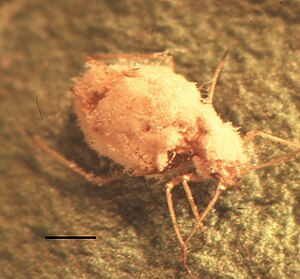Fly-killer mushrooms
| Fly-killer mushrooms | ||||||||||||
|---|---|---|---|---|---|---|---|---|---|---|---|---|

Green peach aphid ( Myzus persicae ) infected with Pandora neoaphidis |
||||||||||||
| Systematics | ||||||||||||
|
||||||||||||
| Scientific name of the subdivision | ||||||||||||
| Entomophthoromycotina | ||||||||||||
| Humber | ||||||||||||
| Scientific name of the order | ||||||||||||
| Entomophthorales | ||||||||||||
| G. Winter |
The fly-killer mushrooms (Entomophthorales) are an order that used to belong to the yoke mushrooms (Zygomycetes), but today they form a separate group within the mushrooms . The relatives are mainly parasitic fungi that attack insects . Other species within the group live parasitically on plants or on other animals, including mammals and humans. In addition to these parasitic species, there are also saprophytes that live in dung .
features
As a youth form , the fungi have a thallus that is not segmented by septa . From this a mycelium develops , the hyphae of which consists of many more nuclear cells .
For asexual reproduction, the fungi form spores in the sporangia . In other species, conidia develop from the sporangia. These conidia are known as angioconidia and sit on club-shaped supports from which they can be actively thrown off, whereby they can fly up to two centimeters.
Systematics
Within the mushrooms, the fly-killer fungi are probably the sister group of the head molds ( Mucorales ), which live mainly saprophytic, but which also contain a number of parasitic species. This relationship is justified primarily with the very similar course of development and the transformation of the sporangia into conidia, whereby there are different stages of conidia development in both groups.
Within the fly-killer fungus, two families are distinguished, called Basidiobolaceae and Entomophthoraceae . The main characteristic of the members of the first group are very large gametangia , in which a fusion takes place without enclosing each other beforehand. The zygospores are formed in the larger female gametangia.
Within the Basidiobolaceae, for example, Basidiobolus ranarum lives on the excrement of frogs and lizards, while other Basidiobolus species cause infectious skin and connective tissue diseases in humans and other mammals as well as in birds. The Conidiobolus species, which also belong to this family, parasitize in insects. The best-known species of the Entomophthoraceae is the fly killer ( Entomophthora muscae ), which causes regular mass deaths of houseflies in autumn . Other species of the genus, such as the genera Delacroicia and Zoophthora, parasitize in insects, while Pandora , Ancylistes and Completoria species live on the prothallia of algae and ferns .
Humans and fly killer mushrooms
The fly killer mushrooms are relevant for humans in two ways. Some species of the group parasitize on the skin and in connective tissues of mammals, including humans. In addition to several types of head mold , they are causative agents of the relatively unspecific zygomycoses , which can develop into life-threatening diseases for those affected. On the other hand, due to their host specificity, fly killer fungi which are pathogenic to insects play a role in biological pest control , in which they can be used specifically against agricultural pests such as lice .
Individual evidence
- ↑ Indexfungorum ( Memento of the original from October 13, 2007 in the Internet Archive ) Info: The archive link was inserted automatically and has not yet been checked. Please check the original and archive link according to the instructions and then remove this notice.
- ↑ DS Hibbett et al .: A higher-level phylogenetic classification of the Fungi . In: Mycological Research , May 2007; 111 (5): 509-547. Epub 2007 March 13, 2007. PMID 17572334
literature
- Martin Schmiedeknecht: Order fly killer mushrooms, Entomophthorales in: Urania plant kingdom. Viruses, bacteria, algae, fungi . Urania-Verlag, Berlin 2000. ISBN 3-332-01167-7